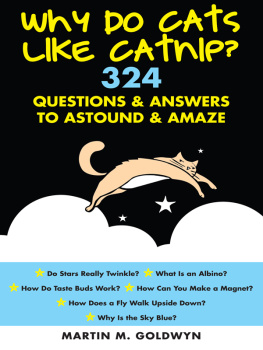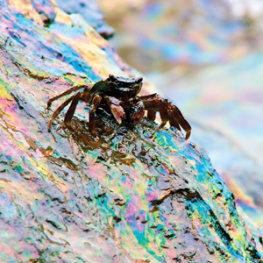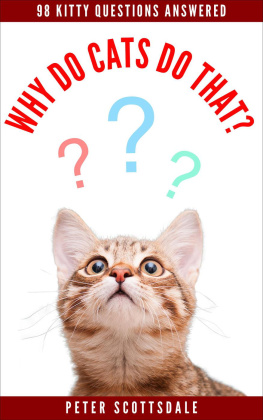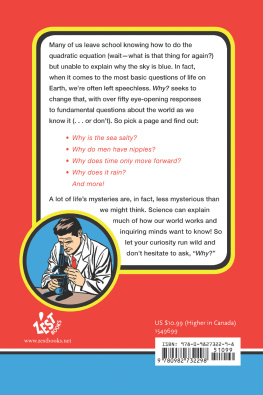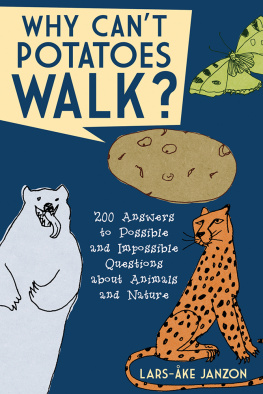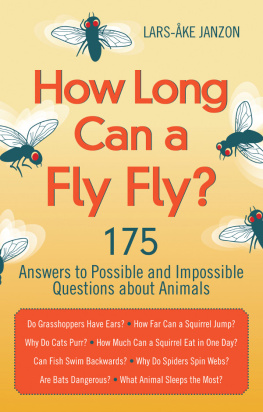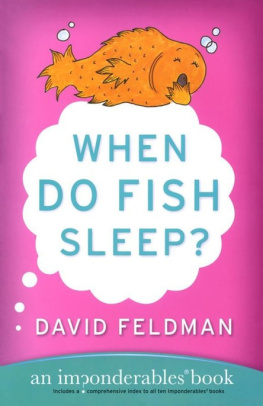WHY DO CATS
LIKE CATNIP

WHY DO CATS
LIKE CATNIP
324
QUESTIONS & ANSWERS
TO ASTOUND & AMAZE
MARTIN M. GOLDWYN

I dedicate this book to
STEVEN
LANI
and
STACI
with love
Copyright 1979, 2012 by Martin M. Goldwyn. Originally published as How a Fly Walks Upside Down. Reprinted by arrangement of Citadel Press/ Kensington Publishing Corp.
All Rights Reserved. No part of this book may be reproduced in any manner without the express written consent of the publisher, except in the case of brief excerpts in critical reviews or articles. All inquiries should be addressed to Skyhorse Publishing, 307 West 36th Street, 11th Floor, New York, NY 10018.
Skyhorse Publishing books may be purchased in bulk at special discounts for sales promotion, corporate gifts, fund-raising, or educational purposes. Special editions can also be created to specifications. For details, contact the Special Sales Department, Skyhorse Publishing, 307 West 36th Street, 11th Floor, New York, NY 10018 or info@skyhorsepublishing.com.
Skyhorse and Skyhorse Publishing are registered trademarks of Skyhorse Publishing, Inc., a Delaware corporation.
Visit our website at www.skyhorsepublishing.com.
10 9 8 7 6 5 4 3 2 1
Library of Congress Cataloging-in-Publication Data is available on file.
ISBN: 978-1-61608-575-9
Printed in China
CONTENTS
Science, reflected in everything around us, comes from a Latin root that means knowledge. We are all born with inquisitive minds and can enjoy the fascination of scientific information if it is presented simply. But somehow science often makes people cowerenough to make students drop a course because they feel it is too technical. As a teacher, I have always been concerned with how scientific principles could be taught in a matter-of-fact, appealing manner. I do not mean that basic laws and principles should be compromised, but that they could be made more accessible to those who show an interest but who do not wish to delve into the more intricate aspects.
Having taught science in high school for some years, I have heard students ask hundreds of questions that ranged far afield from the work at hand, like Why does sand come in different colors? Why does paint peel? Why cant ashes burn? Where do seashells get their colors? Why do mosquito bites itch and swell? Why dont birds get electrocuted? and Is there anything that is immortal?
To determine which questions were most frequently asked, I began to collect and record the most thoughtful and serious ones that arose over the years. By making these part of the course, and setting aside time for informal discussion, I hoped to let the students see the relevancy of science to their lives. In time I was able to gather a variety of questions covering a broad range of topics.
Another source of questions for class discussion emanated from the hundreds of science fair projects I sponsored. For example, I learned from a girl who is now practicing medicine which animal made the strongest glue in the world. A student whose father had a multivaried fruit tree provided me with the question, Can a tree grow more than one kind of fruit?
It was gratifying to see this question-and-answer approach so well received by my classes, and from there it was only a logical progression to consider gathering the material into a book, Ive attempted to maintain a style that is both light and accurate, adding a touch of humor wherever I could. In many instances I was required to capture the essence of difficult concepts while at the same time keeping the technical language to a minimum. However, a few topics remained which required the use of some technical terms in order to retain their accurate scientific meaning.
How important is science to our lives? Pick any object around you and consider how some phase of science entered into its development and manufacture. Though it may seem to us that the world is in constant flux, and, to paraphrase Thomas Wolfe, we cant go home again, in reality the laws of nature be they physics, chemistry, botany, biology or whateverremain unchanged, and it is the work of scientists to uncover their secrets. Our enlarged understanding has enabled us to create such twentieth-century phenomena as space exploration, lasers, and exotic chemicals and antibiotics. But nevertheless, the laws of nature are immutable, and it is this constancy that enables us to make scientific progress. For instance, we can rely on the fact that from primordial time to the present, two atoms of hydrogen and one atom of oxygen unite to form one molecule of water. The chameleon has been changing its color and fish have been surviving in the freezing Arctic for millions of years, while earthworms, roaches and many insects have likewise survived the millennia. But it is we who are only now recognizing the plan of their existence and learning to understand it.
To find answers to these questions I consulted books in the fields of general science, biology, physics, astronomy, earth science, marine biology, medical and scientific Journals and reports, and many other sources. Uppermost in my mind was a desire to reach anyone, young or old, with a sense of inquiry. 1 hope 1 have achieved my aim.
To the many friends in the various fields of science who have reviewed the contents and helped edit, I am very grateful. I owe special thanks to Bert Bond, a teacher of physics, biology, and marine science, whose encouragement and advice is most gratefully acknowledged. And thanks also goes to my wife Goldie for her continued patience and help throughout this entire project.

If it were possible for you to get confidential with a talking mule, he would probably tell you that he has no pride in his ancestors, and no hope for posterity. He is the offspring of a male donkey and a female horse, which is the usual arrangement in order to obtain in the offspring the best qualities of each parent. The horse is larger, a lot more handsome, and learns more easily. On the other hand, the donkey is more disease-resistant, sure-footed, and can perform work under conditions that would make a sensible horse rebel. However, and unfortunately, all male mules are born sterile, and with a few exceptions, the females are also sterile. But there is one dubious consolation for the mule. He does not have to worry about the mule population explosion.

The secret lies in the hump on his back. Contrary to common belief, it does not contain a crooked spine. Its a solid mass of energy-producing fat, weighing about 80 pounds or more. This is a food reserve station or storage house for the energy to be expended on long trips over hot desert sand. When the camel is starved, the hump almost disappears. The fat in the hump is used up while energy is created, but in this process of change, for every pound of fat about a pint of water is produced. Thus, by excreting very little, and by being one of the few animals capable of recycling its liquid body waste, it is able to go for days without water, Thus you see that an Arab used-camel buyer, about to make a long journey, would probably check the size of the camels hump to insure good mileage capability, whereas you and I would check our cars for gas, water and oil.

